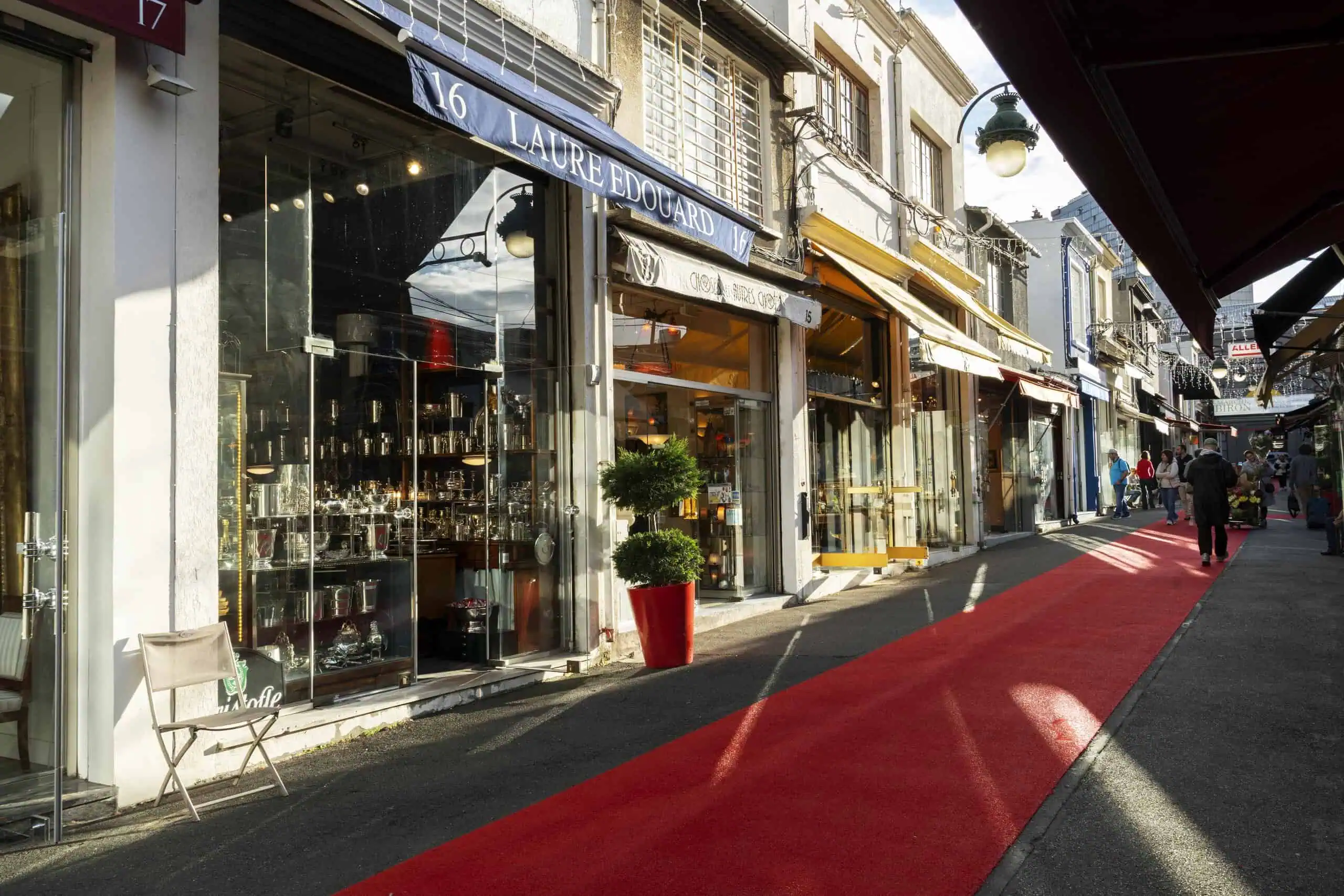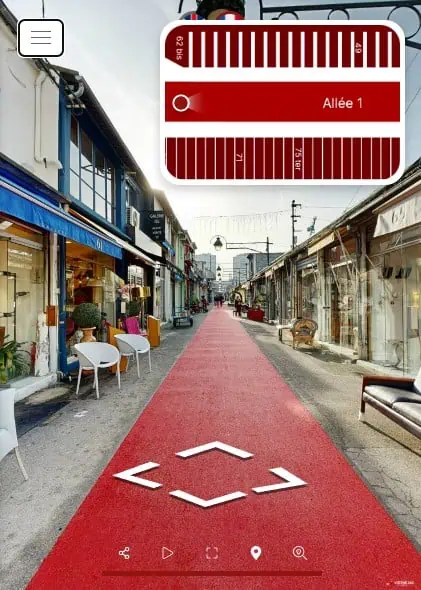Serge Belloni Le peintre de Paris (1925-2005) La Rue Piat huile sur toile vers 1960
Serge Belloni surnommé Le Peintre de Paris, consacra sa vie de peintre à retranscrire jour après jour, par tous les temps, le visage de Paris.
Avec beaucoup de qualité Serge Belloni, peint une belle Vue de la Rue Piat à Belleville. Il affectionne l’automne, le début de l’hiver ou les arbres dépouillés de leurs feuilles lui permettant de montrer l’architecture et l’âme du beau Paris.
Notre tableau est à rapprocher d’un tableau de Serge Belloni conservé au Musée Carnavalet : Les escaliers de la rue Villin et le clocher de l’église Saint-Joseph des Nations Vers 1960 acquis par le musée en 1962. N° d’inventaire P1991.
Dimension sans cadre : Hauteur 74 cm – Longueur 92 cm.
Dimensions avec cadre : Hauteur 97 cm – Longueur 116 cm.
En très bon état de conservation, nous présentons ce tableau dans son état d’usage, servi par un joli cadre en bois à patine dorée.
Biographie :
Serge Belloni, dit Le Peintre de Paris, est le fils du tapissier Luigi Belloni et de Elvira Belloni née Molinari. Il arrive à Paris en 1933 où il étudie la peinture à l’École Supérieure des Beaux-Arts de Paris. Il expose ses toiles à partir de 1946.
Premier prix de peinture à Versailles (1949), prix Marie Bashkirtseff (1952), Médaille d’argent de la Ville de Paris, Médaille de vermeil de la Ville de Paris (1980).
Serge Belloni est né à Plaisance, en Italie, le 25 février 1925 ; dès son enfance, il vit à Paris, faubourg Saint-Antoine, ou ses parents habitent depuis de de nombreuses années. Son père, artisan, y exerce le métier de tapissier-décorateur.
Serge Belloni doit travailler à mi-temps pour payer ses études à l’École des Beaux-Arts ; ce sont des années difficiles huile marqueront. A cette époque, il se lie d’amitié avec Lucien Moretti et Gérard Blondel.
Serge Belloni se manifeste très jeune dans des expositions, suivant dès ses débuts un chemin solitaire, loin des groupes de genre.
Il organise sa première exposition à Paris, à l’âge. De 21 ans ; dès lors il vivra uniquement, et sans compromis, de sa peinture, en portant, comme il aime à le dire, chaque jour sa croix. Par n’importe quel temps, il peint « sur le motif ». De nombreux voyages en Hollande lui permettent d’étudier, sur place, les secrets des maîtres flamands. Il travaille à la redécouverte des découvertes techniques anciennes qu’il ne cessera plus de perfectionner. Il utilise la technique la peinture à l’œuf.
Serge Belloni travaille tous les jours, en toute saison, sans jamais s’arrêter, comme si la vie lui échappait à chaque instant. Ses toiles figurent dans les plus importantes collections : Paris, Milan, Moscou, New-York…
Serge Belloni décède à Menton le 28 octobre 2005.
Musées :
Musée Carnavalet à Paris ou plusieurs de ces œuvres sont conservées.
Musée CA’ Pesaro à Venise.
Bernard de Montgolfier
Inspecteur général des musées de la ville de Paris – Conservateur en chef du musée Carnavalet
À chaque époque de son histoire, depuis la Renaissance, Paris a trouvé des peintres capables d’en scruter le visage permanent ou fugitif, et de le transmettre à la postérité. Comme on peut le vérifier à Carnavalet, la ville du XVIIe siècle vit pour nous grâce à Abraham de Verwer et d’autres spécialistes du paysage urbain dont les noms ne nous sont pas connus. Le Paris de Louis XV et de Louis XVI a été fidèlement représenté par Grevenbroeck, Raguenet, P.A. de Machy et Hubert Robert. Au temps du romantisme, le spectacle de la capitale a inspiré Bouhot, Canella et beaucoup de petits maîtres, mais aussi Corot et Georges Michel. Dans la seconde moitié du XIXe siècle, Paris a eu certains impressionnistes comme interprètes, à côté de Lépine, Jongkind et d’observateurs comme Jean Béraud et Luigi Loir. Plus près de nous, la tradition a été continuée par Bonnard, Marquet, Utrillo. Il serait dommage que, de nos jours, la dictature de l’art non-figuratif et le recours commode à la photographie – quel que soit l’intérêt de son apport – aient pour effet de dissuader les bons peintres de prendre Paris pour modèle. Le Paris de la seconde moitié du XXe siècle se doit d’avoir lui aussi ses interprètes, car le visage de la ville reste un thème inépuisable et susceptible de maintes variations selon la personnalité des artistes. À la question : pourquoi peindre encore Paris ? que certains peuvent se poser, l’œuvre de Serge Belloni apporte une réponse courageuse et convaincante.
Né en Italie, Serge Belloni aime planter son chevalet le long des canaux et devant les façades roses de Venise, dont il sait traduire la poésie intemporelle. Il a d’autre part créé un genre, celui des tableaux de fleurs sur fond d’or. Mais c’est visiblement de Paris, où il s’est fixé, qu’il tire le plus volontiers son inspiration. Tout en s’inscrivant sans aucune honte dans la tradition séculaire du paysage urbain, Serge Belloni la rajeunit par la sensibilité personnelle de son regard, un regard attentif où se devine beaucoup d’amour. Beaucoup de lieux parisiens l’ont vu au travail. De Belleville et de Montmartre, de leurs vieux murs et de leurs rues accidentées, il a saisi la poésie discrète et un peu mélancolique. La porte Saint-Denis, la roseraie de Bagatelle, tel vieux bistrot du centre sont parmi les divers sujets qui ont tenté sa curiosité. Mais il ne cache pas sa prédilection pour le paysage qui a toujours fait la gloire de Paris : celui de la Seine avec sa courbe harmonieuse, ses îles et ses rives, avec ses ponts et ses quais, avec les monuments qui en jalonnent le cours depuis Notre-Dame jusqu’à la tour Eiffel. Ce paysage depuis longtemps cher aux peintres, le voici donc encore dans son ampleur et sa grâce, Serge Belloni ayant su y découvrir à son tour l’âme de la ville.
Il arrive que le printemps, l’été ou l’automne parent de leurs couleurs les sujets choisis par l’artiste. Mais c’est l’hiver qui est, pour Serge Belloni, la vraie saison de Paris. L’hiver, parce qu’il dépouille les arbres, les réduit au fin réseau de leurs branches, et permet ainsi de mieux saisir le subtil accord du ciel, de l’eau et des pierres. L’hiver, parce qu’il donne à la lumière ses variations les plus captivantes, à la couleur ses nuances les plus précieuses. Pour Serge Belloni, le froid, les nuages, la pluie et la neige sont des amis, et il ne met aucune intention morose dans cet attachement. C’est l’hiver qui lui procure l’occasion de mettre en jeu toutes les ressources de son métier de peintre, un beau métier solide et réfléchi, où l’on ne découvre aucune concession aux caprices de la mode.
Interprète sensible autant que fidèle du paysage parisien, Serge Belloni a sa place légitime dans ce musée consacré au Paris de tous les temps. Il y est présent sous la forme transitoire de cette exposition qu’il a lui-même conçue, à juste titre, comme un « hommage à Paris ». Il y restera de manière durable grâce à des tableaux faisant désormais partie de ses collections : un premier acquis par la Ville dès 1963 ; un autre offert par Mr Jean Griot, et deux que l’établissement doit à la générosité de leur auteur. Qu’il me soit permis de remercier Serge Belloni pour ce don et pour l’aide qu’il a bien voulu apporter à la mise en œuvre d’un projet conforme à la vocation parisienne de Carnavalet.
Musée Carnavalet : Hommage à Paris 11 février – 13 avril 1986.
Serge Belloni Le peintre de Paris (1925-2005) La Rue Piat oil on canvas circa 1960
Serge Belloni, nicknamed Le Peintre de Paris, devoted his life as a painter to transcribing the face of Paris, day after day, in all weathers.
With great skill, Serge Belloni paints a fine Vue de la Rue Piat in Belleville. He is particularly fond of autumn, early winter and trees stripped of their leaves, allowing him to show the architecture and soul of beautiful Paris.
Our painting is to be compared with a painting by Serge Belloni kept at the Musée Carnavalet: Les escaliers de la rue Villin et le clocher de l’église Saint-Joseph des Nations Vers 1960 acquired by the museum in 1962. Inventory no. P1991.
Sizes unframed: H 29.13 In. – W 36.22 In.
Sizes framed: H 38.18 In. – W 45.66 In.
In a very fine condition, we are presenting this painting in its original condition, framed in an attractive wooden frame with a golden patina.
Biography:
Serge Belloni, known as The Painter of Paris, is the son of the upholsterer Luigi Belloni and Elvira Belloni née Molinari. He moved to Paris in 1933 where he studied painting at the Ecole supérieure des Beaux-Arts de Paris. He exhibited his paintings from 1946.
First prize for painting in Versailles (1949), Marie Bashkirtseff prize (1952), Silver Medal of the City of Paris, Vermeil Medal of the City of Paris (1980).
Serge Belloni was born in Piacenza, Italy, on February 25, 1925. As a child, he lived in Paris, in the Faubourg Saint-Antoine, where his parents had lived for many years. His father, a craftsman, worked as an upholsterer-decorator.
Serge Belloni had to work part-time to pay for his studies at the Ecole des Beaux-Arts; these were difficult years that left their mark. At that time, he became friends with Lucien Moretti and Gérard Blondel.
At a very young age, Serge Belloni showed his work in exhibitions, following a solitary path from the beginning, far from genre groups.
He organized his first exhibition in Paris at the age of 21; from then on he lived solely, and without compromise, from his painting, carrying, as he likes to say, his cross every day. Whatever the weather, he painted “on the spot”. Numerous trips to Holland allowed him to study, on the spot, the secrets of the Flemish masters. He worked on the rediscovery of ancient techniques that he would never stop perfecting. He uses the egg painting technique.
Serge Belloni works every day, in all seasons, without ever stopping, as if life was escaping him at every moment. His paintings are in the most important collections: Paris, Milan, Moscow, New York …
Serge Belloni died in Menton on October 28, 2005.
Museums :
Carnavalet Museum in Paris where several of these works are kept.
Museum CA’ Pesaro in Venice.
Bernard de Montgolfier
Inspector General of Museums of the City of Paris – Chief Curator of the Carnavalet Museum
At each period of its history, since the Renaissance, Paris has found painters capable of scrutinizing its permanent or fleeting face and transmitting it to posterity. As can be verified at Carnavalet, the 17th-century city lives for us thanks to Abraham de Verwer and other urban landscape specialists whose names are not known to us. The Paris of Louis XV and Louis XVI has been faithfully represented by Grevenbroeck, Raguenet, PA de Machy, and Hubert Robert. In the time of romanticism, the spectacle of the capital inspired Bouhot, Canella, and many little masters, but also Corot and Georges Michel. In the second half of the 19th century, Paris had certain impressionists as interpreters, alongside Lépine, Jongkind, and observers like Jean Béraud and Luigi Loir. closer to us, the tradition was continued by Bonnard, Marquet, and Utrillo. It would be a pity if, nowadays, the dictatorship of non-figurative art and the convenient recourse to photography – whatever the interest of its contribution – had the effect of dissuading good painters from taking Paris as a model. The Paris of the second half of the 20th century must also have its interpreters because the face of the city remains an inexhaustible theme and is subject to many variations depending on the personality of the artists. To the question: why still paint Paris? that some may ask, the work of Serge Belloni provides a courageous and convincing answer. the dictatorship of non-figurative art and the convenient recourse to photography – whatever the interest of its contribution – had the effect of dissuading good painters from taking Paris as a model. The Paris of the second half of the 20th century must also have its interpreters because the face of the city remains an inexhaustible theme and is subject to many variations depending on the personality of the artists. To the question: why still paint Paris? that some may ask, the work of Serge Belloni provides a courageous and convincing answer. the dictatorship of non-figurative art and the convenient recourse to photography – whatever the interest of its contribution – had the effect of dissuading good painters from taking Paris as a model. The Paris of the second half of the 20th century must also have its interpreters because the face of the city remains an inexhaustible theme and is subject to many variations depending on the personality of the artists. To the question: why still paint Paris? that some may ask, the work of Serge Belloni provides a courageous and convincing answer. why still paint Paris? that some may ask, the work of Serge Belloni provides a courageous and convincing answer. why still paint Paris? that some may ask, the work of Serge Belloni provides a courageous and convincing answer.
Born in Italy, Serge Belloni likes to plant his easel along the canals and in front of the pink facades of Venice, whose timeless poetry he knows how to translate. He also created a genre, that of paintings of flowers on a gold background. But it is obviously from Paris, where he settled, that he most readily draws his inspiration. While unashamedly following the age-old tradition of the urban landscape, Serge Belloni rejuvenates it through the personal sensitivity of his gaze, an attentive gaze in which a great deal of love can be guessed. Many places in Paris have seen him at work. From Belleville and Montmartre, from their old walls and their rugged streets, he captured the discreet and somewhat melancholy poetry. The Saint-Denis gate, the Bagatelle rose garden, and such an old bistro in the center are among the various subjects that have tempted his curiosity. But he does not hide his predilection for the landscape which has always been the glory of Paris: that of the Seine with its harmonious curve, its islands, and its banks, with its bridges and its quays, with the monuments which mark out its course since Notre Dame to the Eiffel Tower. This landscape has long been dear to painters, here it is again in its fullness and grace, Serge Belloni having in turn discovered the soul of the city.
It happens that spring, summer, or autumn adorn the subjects chosen by the artist with their colors. But it is winter which, for Serge Belloni, is the real season in Paris. Winter, because it strips the trees, reduces them to the fine network of their branches, and thus makes it possible to better grasp the subtle harmony of the sky, the water, and the stones. Winter, because it gives light its most captivating variations and colors its most precious nuances. For Serge Belloni, the cold, the clouds, the rain, and the snow are friends, and he puts no gloomy intention into this attachment. It was winter that gave him the opportunity to bring into play all the resources of his trade as a painter, a beautiful, solid, and thoughtful trade, in which one discovered no concessions to the whims of fashion.
A sensitive as well as faithful interpreter of the Parisian landscape, Serge Belloni has his rightful place in this museum dedicated to the Paris of all times. He is present there in the transitory form of this exhibition which he himself conceived, quite rightly, as a “tribute to Paris”. It will stay there permanently thanks to paintings that are now part of its collections: a first one acquired by the City in 1963; another offered by Mr Jean Griot, and two that the establishment owes to the generosity of their author. Allow me to thank Serge Belloni for this donation and for the help he kindly provided for the implementation of a project in keeping with the Parisian vocation of Carnavalet.
Carnavalet Museum: Homage to Paris February 11 – April 13, 1986.

































